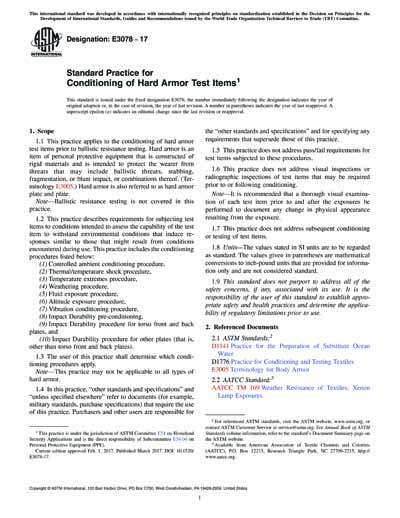Most recent
ASTM E3078-17
Standard Practice for Conditioning of Hard Armor Test Items
1.1 This practice applies to the conditioning of hard armor test items prior to ballistic resistance testing. Hard armor is an item of personal protective equipment that is constructed of rigid materials and is intended to protect the wearer from threats that may include ballistic threats, stabbing, fragmentation, or blunt impact, or combinations thereof. (Terminology E3005.) Hard armor is also referred to as hard armor plate and plate.
Note—Ballistic resistance testing is not covered in this practice.
1.2 This practice describes requirements for subjecting test items to conditions intended to assess the capability of the test item to withstand environmental conditions that induce responses similar to those that might result from conditions encountered during use. This practice includes the conditioning procedures listed below:
(1) Controlled ambient conditioning procedure,
(2) Thermal/temperature shock procedure,
(3) Temperature extremes procedure,
(4) Weathering procedure,
(5) Fluid exposure procedure,
(6) Altitude exposure procedure,
(7) Vibration conditioning procedure,
(8) Impact Durability pre-conditioning,
(9) Impact Durability procedure for torso front and back plates, and
(10) Impact Durability procedure for other plates (that is, other than torso front and back plates).
1.3 The user of this practice shall determine which conditioning procedures apply.
Note—This practice may not be applicable to all types of hard armor.
1.4 In this practice, “other standards and specifications” and “unless specified elsewhere” refer to documents (for example, military standards, purchase specifications) that require the use of this practice. Purchasers and other users are responsible for the “other standards and specifications” and for specifying any requirements that supersede those of this practice.
1.5 This practice does not address pass/fail requirements for test items subjected to these procedures.
1.6 This practice does not address visual inspections or radiographic inspections of test items that may be required prior to or following conditioning.
Note—It is recommended that a thorough visual examination of each test item prior to and after the exposures be performed to document any change in physical appearance resulting from the exposure.
1.7 This practice does not address subsequent conditioning or testing of test items.
1.8 Units—The values stated in SI units are to be regarded as standard. The values given in parentheses are mathematical conversions to inch-pound units that are provided for information only and are not considered standard.
1.9 This standard does not purport to address all of the safety concerns, if any, associated with its use. It is the responsibility of the user of this standard to establish appropriate safety and health practices and determine the applicability of regulatory limitations prior to use.
ASTM International [astm]

